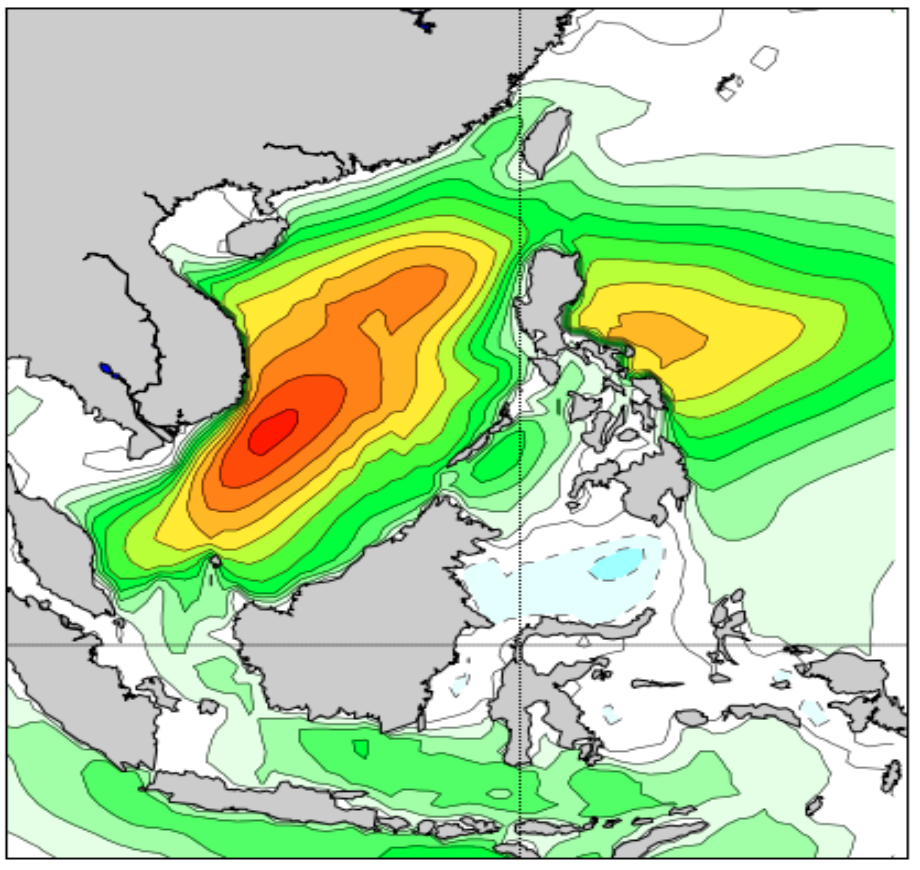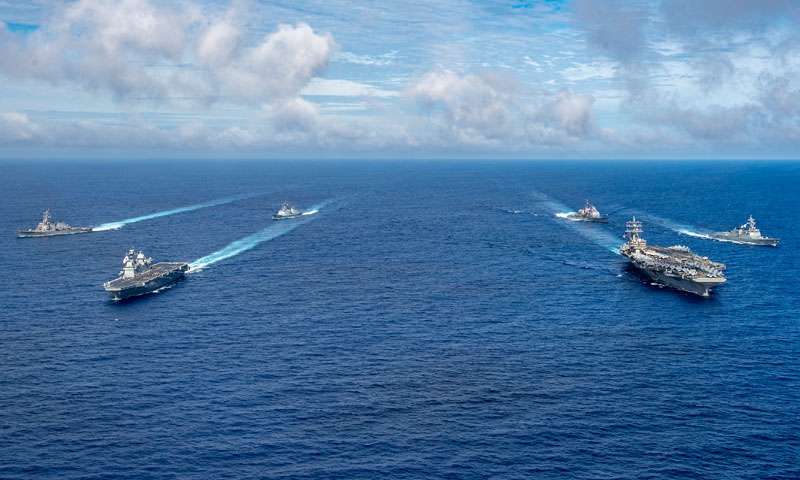The analysis of global patterns can help scientists develop predictions about the conditions a specific region might experience in the coming weeks, months or years. One method they do this is by looking for precursor conditions in the ocean and atmosphere that might be indicators of what’s to come in the region.
For his 2021 doctoral thesis at the Naval Postgraduate School (NPS), U.S. Navy Lt. Cmdr. Kellen Jones wanted to see if there were large-scale climate events that serve as precursors to Santa Ana winds, which can lead to devastating wildfires in Southern California.
“We focused on looking at 164 different Santa Ana winds from 1979 to 2018, and we were able to determine what that weather pattern looks like across the globe,” Jones recalls. “We found a very unique signature … a unique thumbprint in the global climate system that occurs during and also before seeing a Santa Ana wind event.”
He and his advisor Dr. Tom Murphree, now a research associate professor emeritus in NPS’ Department of Meteorology, used machine learning and other methods to determine the related events that took place in the tropics and the Indian Ocean before Santa Ana winds materialized in California.
Jones’ research demonstrated the possibility to predict Santa Ana winds early through looking at larger, global systems. In their analysis, the team was able to correctly predict 84 percent of November Santa Ana wind events from 1970 to 2018 at forecast lead times of 2-4 weeks. Moreover, they correctly predicted three to four weeks ahead of six major Santa Ana events that were associated with 17 major wildfires.
“These results really showed us that we found what looked like unique fingerprints, but also that those fingerprints had predictive skill,” Jones says.
With further research, Jones’ discovery certainly has the potential to support wildfire suppression in a state that has been devastated by fire in recent years, and the disruption caused by these wildfires can certainly impact Naval activities in Southern California and elsewhere.
It was the capability to analyze and predict using complex atmospheric models that demonstrated Jones’ skill in ocean/atmospheric problem solving and decision superiority that was of the greatest immediate value to his Navy career. Following his June 2021 graduation from NPS, Jones is now performing those duties as the METOC Officer on the Wasp-class amphibious assault ship, USS Makin Island.
The university maintains a proud legacy in the education of Naval Oceanography officers, many of whom attend NPS. In fact, promotion to the rank of commander or above requires an advanced education leading to the Master of Science in Meteorology and/or Physical Oceanography that is almost exclusively obtained at NPS. Jones is also part of a much smaller community of Naval Oceanographers who continue on at NPS for a doctoral degree.
But advanced education is not the only impactful legacy made possible by the efforts of NPS’ METOC community. Jones’ research was made possible by a larger Naval interagency project called the Advanced Climate Analysis and Forecasting (ACAF) System. Developed in 2007, ACAF is a collaborative effort between Murphree’s team at NPS, the Fleet Numerical Meteorology and Oceanography Center (FNMOC), and a company called Clear Science, Inc.
ACAF provides climate data and long-range, probabilistic forecasts to assist in critical decision making. It can be used to prepare for field conditions, look for conditions in which to train or test equipment, or explain past events (ACAF’s database goes back to the 1950s). Understanding what the wind and waves are going to do before a mission could be the difference between life and death.
“Environmental conditions can be just as deadly as the enemy,” Murphree says.
ACAF is accessible to anyone with a CAC card, and gets on average about 2,000 to 4,000 products generated a month per security enclave. Add in the products generated through classified networks, and that number more than doubles. Murphree estimates over 600 NPS students have used ACAF for thesis work over the years, usually METOC students but it has also been used for theses relating to systems engineering, defense analysis, and undersea warfare.
 A sample ACAF product demonstrating some of the observed effects of climate change on ocean surface wave height.
A sample ACAF product demonstrating some of the observed effects of climate change on ocean surface wave height.
“Usually when people hear the term ACAF, they think of this tool or application that folks in the fleet can go in and utilize to obtain their own products on the fly, but it really encompasses an entire project or approach as to how the Navy should be approaching climate,” explains Megan Hutchins, head of the climate division at FNMOC. Hutchins got a masters from NPS in 2010 after conducting research on climate-scale predictions of Arctic sea ice with Murphree.
In 2006, the Navy was just beginning to recognize the need to substantially modernize its approach to providing climate support for the Fleet. For example, the Navy meteorology and oceanography (METOC) community was getting familiar with how modern climate science could be used to help Naval planners prepare for climate variations (like El Nino and La Nina) and the impacts of climate change on winds, waves, clouds, sea ice, and other climate system variables that affect Naval operations. That recognition led to the start of the ACAF project.
Murphree, who has been the cornerstone of climate research at NPS for decades, worked with his students, FNMOC, and the CEO of Clear Science, Bruce Ford, to create this evergrowing and updating ACAF system, which provides online access to a vast array of climate data sets, data analysis and visualization tools, and the data and methods needed to produce predictions for future climate system conditions.
“Murphree has been a national asset in terms of pioneering smart climatology and applying modern methods for most of my career in the Navy,” Ford says.
Ford also was a student of Murphree at NPS and later became a research assistant for him before starting Clear Science in 2003. NPS was utilizing Clear Science’s expertise in data organization and analysis when the idea for ACAF came up.
“I was kind of [Murphree’s] go-to to write scripts and pull things out of datasets and help him prepare for papers and help the thesis students as well,” Ford says.
Murphree, FNMOC, and Ford wanted to see if they could create an online system that would allow users to look at the long-term average conditions for specific operating areas at different times of the year. They also wanted the system to help users analyze and predict both variations for those averages (known as climate anomalies) and climate change impacts.
“We walked before we could run,” says Ford. “And I was able to establish the technical underpinnings that would allow this to happen on a mass scale.”
Though it was originally developed only as an internal tool for FNMOC, it has now become an essential tool for Navy support providers within the meteorology and oceanography community to help understand the conditions of an area before operations begin help to ensure safety of the troops.
Say, for example, METOC personnel might need to provide information to support the planning of an operation in a specific part of the world. Another one of Murphree’s thesis students, Lt. Cmdr. Matthew Hardie, was able to predict conditions in a defined region five months out using multiple
regression methods to analyze data provided by the ACAF system and develop prediction models based on remote precursor conditions. Hardie’s research also identified major ways in which global warming and climate change affect the region. A warmer environment can impact strategy and tactics, and the performance and productivity of sailors and equipment, such as sonar and radar systems (see the infographic for more info on the potential operational impact of climate change).
Clear Science and FNMOC are working on the biggest update to ACAF yet. Ford says it will improve the user interface and capacity ten times over. Murphree will continue his work with the NPS Department of Meteorology and the NPS Climate Security Network as an advisor. And NPS Meteorology Department Chair Dr. Wendell Nuss plans to continue climate research within the department that builds off of Murphree’s work.
“Presently, we have numerous master’s thesis students doing climate-related research,” said Nuss. “We hope to be able to bring in or develop some new faculty leadership in this important area of science.”
- U.S. Navy Lt. Cmdr. Kellen Jones research https://apps.dtic.mil/sti/pdfs/AD1059963.pdf
- Metrology department https://nps.edu/web/meteorology
- Climate Security Network https://nps.edu/web/climate-and-security/about
- Navy meteorology and oceanography (METOC) community https://www.metoc.navy.mil
- Fleet Numerical Meteorology and Oceanography Center (FNMOC) https://www.metoc.navy.mil/fnmoc/fnmoc.html



